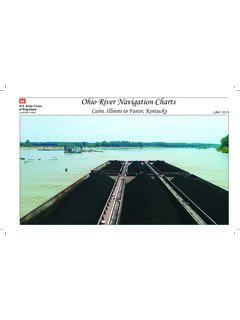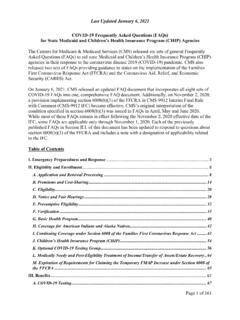Transcription of U.S. Army Corps of Engineers Permitting Process Information
1 Army Corps of Engineers Permitting Process Information The Permit Process consists of a number of steps involving the applicant, the Corps of Engineers , public and/or private organizations, and Federal, state and/or local agencies. General Information related to the Permitting Process is outlined below. Processing Steps The basic form of authorization used by Corps districts is the standard permit. Processing such permits involves evaluation of individual, project specific applications in what can be considered three steps: pre-application consultation (for major projects), project review, and decision-making. The following is a general description of the step-by-step procedure the Corps uses to evaluate a typical standard permit application: 1. A pre-application consultation is recommended (see below). 2. The applicant submits ENG Form 4345 and plans through this web site or to the appropriate Corps regulatory office.
2 3. The Corps receives the application and assigns it an identification number. 4. The Corps notifies the applicant if additional Information is required to make the application complete. 5. A public notice is issued within 15 days of receipt of a complete application, to solicit comments from the public, adjacent property owners, interested groups and individuals, local agencies, state agencies, and Federal agencies. 6. The public notice comment period is 15 to 30 days, depending upon nature of activity. 7. The Corps provides the applicant an opportunity to respond to comments received in response to the public notice. 8. The Corps may ask the applicant to provide additional Information to assess environmental impacts or resolve public interest concerns. The Corps may also ask the applicant to modify the project to reduce environmental impacts. 9. The Corps considers all comments and the applicant s responses to those comments, including any proposed modifications of the project.
3 The Corps may discuss project modifications with state and Federal agencies and other interested parties. 10. A public hearing is held, if necessary. 11. The Corps conducts a public interest review evaluation and, if necessary, a section 404(b)(1) guidelines evaluation. 12. The Corps makes a decision on the permit application and explains its decision in a decision document. This decision document may include an environmental assessment or environmental impact statement, a statement of findings or record of decision, a Section 404(b)(1) guidelines evaluation (if necessary), and a public interest review evaluation. 13. If the Corps decides to issue the permit, a copy of the permit is sent to the applicant for his or her signature. If the applicant signs the permit, he or she agrees to the terms and conditions of the permit. If the permit is denied, the Corps will explain to the applicant why the permit was denied.
4 14. If the applicant refuses to sign the permit because he or she does not agree with the conditions in the permit, or if the permit is denied, the applicant can request an administrative appeal of the permit decision. Pre-application consultation usually involves one or more meetings between an applicant, Corps district staff and interested resource agencies (Federal, state, or local). The basic purpose of such meetings is to provide for informal discussions about a proposed activity before an applicant makes irreversible commitments of resources (funds, detailed designs, etc.). The pre-application Process is intended to provide the applicant with an assessment of the viability of some of the more obvious alternatives available to accomplish the project purpose, to discuss measures for reducing the impacts of the project, and to inform the applicant of the factors the Corps must consider in its decision-making Process .
5 Once a complete application is received, the review Process begins. Corps districts operate under what is called a project manager system, where one individual is responsible for handling an application from receipt to final decision. The project manager prepares a public notice, evaluates the impacts of the project and all comments received, negotiates necessary modifications of the project, and prepares appropriate documentation to support a recommended permit decision. The decision to issue or deny a permit is based on the public interest review and, where applicable, a Section 404(b)(1) guidelines analysis or an analysis of the ocean dumping criteria. The public interest review involves an analysis of the foreseeable impacts the proposed work would have on public interest factors, such as navigation, general environmental concerns, wetlands, economics, fish and wildlife values, land use, floodplain values, and the needs and welfare of the people.
6 The benefits and detriments to all public interest factors relevant to each case are carefully evaluated. The permit decision document includes a discussion of the environmental impacts of the project, the findings of the public interest review Process , and any special evaluation required by the type of activity, such as determining compliance with the Section 404(b)(1) guidelines or ocean dumping criteria. The following general criteria are considered in evaluating all applications: 1. The relevant extent of public and private need for the proposed work; 2. Where unresolved conflicts of resource use exist, the practicability of using reasonable alternative locations and methods to accomplish the objective of the proposed structure or work; and 3. The extent and permanence of the beneficial and/or detrimental effects the proposed structure or work is likely to have on public and private uses to which the area is suited.
7 No permit is granted if the proposed project is found to be contrary to the public interest. If the proposed work involves discharges of dredged or fill material into waters of the United States, no permit is granted if the proposed activity is found to be contrary to the Section 404(b)(1) guidelines. The Corps supports strong partnerships with states in regulating water resource development activities. Such partnerships can be achieved through joint permit processing procedures ( , joint permit applications, public notices and public hearings), as well as programmatic general permits founded on effective state programs, transfer of the Section 404 program to states, special area management planning , and regional conditioning of nationwide permits. Alternate Forms of department of Army Permits There are alternate forms of authorization used in certain situations. Letters of permission may be used where, in the opinion of the district engineer, the proposed work would be minor, would not have significant individual or cumulative impacts on environmental values, and should encounter no appreciable opposition.
8 In such situations, the proposal is coordinated with Federal and state resource agencies, and in most cases, adjacent property owners who might be affected by the proposal. However, the public at large is not notified. The public interest review Process is central to the decision-making Process for letters of permission. Another form of authorization is the general permit. There are three types of general permits: nationwide permits, regional general permits, and programmatic general permits. General permits are not normally developed for an individual applicant, but authorize activities the Corps has identified as being substantially similar in nature and causing only minimal individual and cumulative environmental impacts. General permits may authorize activities in a limited geographic area ( , county or state), a particular region of the county ( , group of contiguous states), or the nation. A regional or programmatic general permit is issued by the division or district engineer that has regulatory jurisdiction over the geographic area in which the general permit will be used.
9 The issuance Process for a general permit closely parallels the issuance Process for individual permits, with a public notice, opportunity for a public hearing and detailed decision documentation. Activities that qualify for general permit authorization may proceed, provided the terms and conditions of the general permit are met. However, some general permits may require review of the proposed work by district Engineers before the project proponent can begin construction of the project. A nationwide permit is a type of general permit that authorizes activities on a nationwide basis, unless specifically limited through regional conditions or revoked by division or district Engineers . The latest reissuance of the nationwide permits was published in the January 15, 2002, issue of the Federal Register (67 FR 2020). This Federal Register notice contains the text of the nationwide permits, as well as the general conditions and definitions.
10 Division Engineers can add regional conditions to nationwide permits to restrict their use to ensure that those activities result in minimal adverse environmental effects. You should contact the appropriate Corps district office to determine if there are any regional conditions for the nationwide permits. A regional general permit is a type of general permit that authorizes activities in a particular state or other geographic region. A programmatic general permit is based on an existing state, local or other Federal agency program and designed to avoid duplication with that program. Public Involvement Public involvement plays a central role in the Corps administration of its regulatory program. The major tools used to interact with the public are public notices and public hearings. The public notice is the primary method of advising all interested parties of a proposed activity for which a permit is sought.












